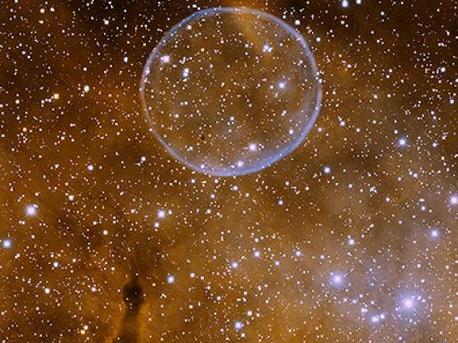Planetary Nebula in the Milky Way
Soap Bubble in Space
 |
The 'soap bubble nebula' formally known as PN G75.5+1.7 and found by three amateur astronomers in July 2008. In this picture North is on the left and East on the bottom.
The first task at hand was to go through all star catalogs and other sources to find information on gas nebula around this particular spot of celestial real estate. After Jurasevich was sure that he discovered something new, he immediately reported it to the IAU. People at IAU were skeptic at first, but finally Lubos Kohoutek from the Observatory Hamburg in Germany was able to find the object on older records of the Palomar Observatory.
PN G75.5+1.7 lies in the outskirts of a giant hydrogen cloud, which makes it very hard to detect. If the nebula is in the same region as the gas cloud, then it is about 4000 light years away from Earth and has a diameter of 5 light years. These planetary nebulae are usually brought into existence when a star like our Sun is dying and sheds its outer layers into space. Jurasevich estimates that this happened for PN G75.5+1.7 about 22,000 years ago.
However astronomers are not quite sure if PN G75.5+1.7 is indeed a normal planetary nebula. The comparison to earlier records shows that the nebula did not change over the last 16 years. Additionally the blue star in the center still shines as bright as before. Both phenomena are unusual for a star in its last phase of life. Astronomers hope to clear up the mystery with further spectroscopic observation. Unfortunately this might prove to be difficult for such a faint nebula.
Rainer Kayser and Redshift live
Planetary Nebula in the Milky Way
Soap Bubble in Space
 |
The 'soap bubble nebula' formally known as PN G75.5+1.7 and found by three amateur astronomers in July 2008. In this picture North is on the left and East on the bottom.
The first task at hand was to go through all star catalogs and other sources to find information on gas nebula around this particular spot of celestial real estate. After Jurasevich was sure that he discovered something new, he immediately reported it to the IAU. People at IAU were skeptic at first, but finally Lubos Kohoutek from the Observatory Hamburg in Germany was able to find the object on older records of the Palomar Observatory.
PN G75.5+1.7 lies in the outskirts of a giant hydrogen cloud, which makes it very hard to detect. If the nebula is in the same region as the gas cloud, then it is about 4000 light years away from Earth and has a diameter of 5 light years. These planetary nebulae are usually brought into existence when a star like our Sun is dying and sheds its outer layers into space. Jurasevich estimates that this happened for PN G75.5+1.7 about 22,000 years ago.
However astronomers are not quite sure if PN G75.5+1.7 is indeed a normal planetary nebula. The comparison to earlier records shows that the nebula did not change over the last 16 years. Additionally the blue star in the center still shines as bright as before. Both phenomena are unusual for a star in its last phase of life. Astronomers hope to clear up the mystery with further spectroscopic observation. Unfortunately this might prove to be difficult for such a faint nebula.
Rainer Kayser and Redshift live





